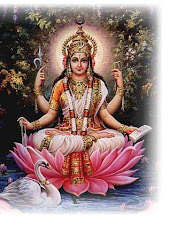Avatar: Avatars are incarnations of a higher being. Avatars are usually sent to earth for a set purpose. Avatars are generally incarnations of vishnu that Hindus worship. There are four main types of avatars Purusha (the original avatars of vishnu), Guna (who controll the three modes of nature), manvantara (who are responsible for creating offspring throughout the world), and Shaktyavesa.
Atman: This word is used in the Hindu religion to identify a person's soul or ones true self beyond their worldly exsistence. This is a basic Hindu principle in which people become "one" with Brahman.
http://en.wikipedia.org/wiki/Avatar
http://en.wikipedia.org/wiki/Atman_%28Hinduism%29 http://www.reference.com/search?q=atman
Monday, October 22, 2007
Vishnu

Vishnu: Vishnu is another one of the three main gods. Vishnu is the preserver of the universe. Vishnu is reborn when there is a crisis on earth. He is reborn as an avatar to fight evil on earth. Vishnu is described as having four arms one arm holds the conch shell, one arm holds the discus, one arm holds the lotus and one arm hold the mace. There are over a thousand names for vishnu including Hari, Rama, and Sriman. Vishnu is worshiped either directly or through avatars.
Asceticism
Asceticism is a religious lifestyle that does not have any worldy pleasures. People who practice asceticism think that their practices are virtous and that they will help them obtain greater spirituality. They think that if they purify their bodies, it will purify their souls and will bring them inner peace. They feel that if they deny themselves certain pleasures, they will have greater freedom in other areas of their lives.
http://en.wikipedia.org/wiki/Asceticism
http://en.wikipedia.org/wiki/Asceticism
Guru
The Guru is a scared teacher of the Hinduism, Buddhism, and Sikhism religion. The Guru is a sacred connection to wisdom and will help a follower find “one’s true self”. The Guru is a divine figure that has teaching influences. In the West, the term guru refers to anyone who acquires followers. It can also be used to describe a person who has authority because of his religious knowledge or skills.
http://en.wikipedia.org/wiki/Guru
http://en.wikipedia.org/wiki/Guru
Yoga
Yoga is believed to be a main part of the Hinduism religion. It is said “There is no Yoga without Hinduism and no Hinduism without Yoga." Yoga is a group of spiritual practices used in the Hinduism religion and many others in India. Yoga is mainly focused on the posture. There are many different branches of yoga: Hatha Yoga, Karma Yoga, Jnana Yoga, Bhakti Yoga, and Raja Yoga. The belief is that the practice of yoga will lead to a connection between the human and the divine and it will lead to a “silence of the mind”.
http://en.wikipedia.org/wiki/Yoga
http://www.hinduwisdom.info/Yoga_and_Hindu_Philosophy.htm
http://en.wikipedia.org/wiki/Yoga
http://www.hinduwisdom.info/Yoga_and_Hindu_Philosophy.htm
Shiva
Shiva: Shiva is one of the main three gods. He is known as the "destroyer". Shiva is described as having several arms, a third eye (this symbolizes his spiritual insight and his ability to burn things that distract from that insight), and a blue throat which he got from drinking a poison to save the world. Shiva's responsibilities are to protect devotees (Hindus) from evil forces, pain, and suffering. Shiva is also known as mahadeva. Shiva is usually worshiped in the form of lingam (a symbol used for worship). People who worship Shiva the most are know as Shaivites or Shaivas.
http://en.wikipedia.org/wiki/Shiva
http://www.pantheon.org/articles/s/shiva.html
http://www.indiantemples.com/beliefs/allaboutshiva.htm
Sunday, October 21, 2007
History
Hinduism is believed to be the oldest religion in the world starting during the late Neolithic Era (5500–2600BCE) . While there is no specific founder of Hinduism, the religion has been related to Buddhism and Jainism due to the close connections these religions shared in India during Buddhism and Jainisms creation. Hinduism came close to extinction in the 7th century due to invasion from the Arab nations and forced conversion to Islam. During this time many Hindu temples throughout India were destroyed and only a small portion of the population, concentrated in southern India, remained with the religion until more accepting leaders took over.
Sources: Dom's memory, http://en.wikipedia.org/wiki/Hinduism#History
Sources: Dom's memory, http://en.wikipedia.org/wiki/Hinduism#History
Subscribe to:
Posts (Atom)

